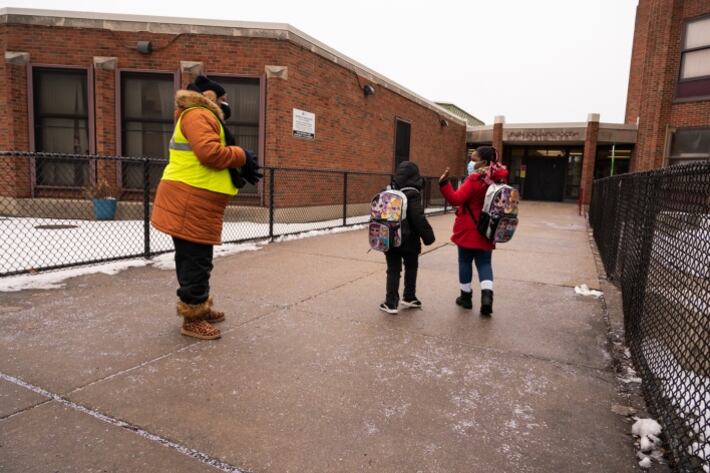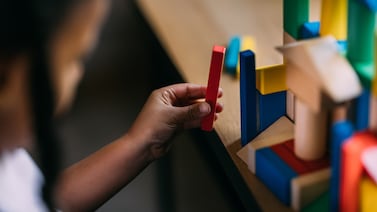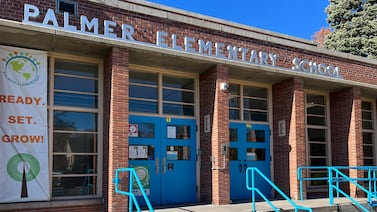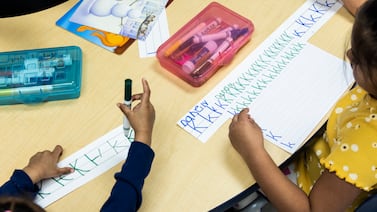Chicago teachers voted by a slim margin to sign an agreement with the school district, officially ending a standoff over campus COVID safety that captured national attention.
The final vote tally was 56% of votes, or 10,342, cast in favor of signing the agreement, with 44%, or 8,278, against. In all, 18,620 of the union’s roughly 25,000 members voted, according to results certified by the union’s elections committee.
Teachers going into the vote said they had mixed feelings about the proposal, which fell short of meeting union leadership’s goals of a temporary period of remote learning during the current COVID surge and a citywide metric for pausing in-person instruction when cases rise.
The agreement establishes school-level metrics that will determine when campuses are flipped remotely, boosts contact tracing by paying teachers extra to fortify the district’s efforts, and sets a goal of securing 100% of parents to opt-in to COVID surveillance testing by Feb. 1 through phone banking and joint CPS-CTU efforts.
The district also agreed under pressure from teachers to distribute KN95 masks to all staff and students and bring back a daily safety screener, though it is up to campuses to make the final decision about whether to restart the electronic screener and have families fill it out daily.
It does not spell out a districtwide metric for closing schools or automatically sign families up for testing, which the union had wanted.
The agreement also does not buffer the district from mass COVID disruptions that plagued it in the fall and that have roiled other districts. Staffing shortages due to the contagious omicron and a substitute crisis have forced administrators to combine classes, call in security guards and paraprofessionals to assist, and send children to the gym, fueling concern among teachers.
As of Wednesday, nearly 11,000 students and 2,300 staff members were under quarantine orders because they had tested positive or had been exposed to a positive COVID case. At some schools, multiple classrooms were “flipped” to remote learning because of COVID cases detected early last week when students returned from winter break. The agreement extends incentives for substitutes in an effort to help recruit them.
The district said Wednesday afternoon that 89% of union members had reported to work in schools. It did not yet have student attendance figures.
In Chicago, vaccinated students who are exposed to COVID may return to classrooms as long as they don’t exhibit any symptoms of COVID-19, rulemaking that follows guidance from the Centers for Disease Control and Prevention and the Illinois State Board of Education. Unvaccinated students currently must quarantine 10 days from the date of exposure — Chicago Public Schools has not yet said whether it will adopt an abbreviated 5-day quarantine period recently recommended by the CDC and the state school board.
How to reopen schools safely to educators and students has been a subject of fierce national debate as the omicron variant causes caseloads to surge, even among the vaccinated.
But Chicago’s standoff stood out for its acrimony and for leading to an abrupt shuttering of campuses that left parents and students stranded without school for five days.
On Wednesday, parents and students said the bitter dispute and the sharp language on both sides left them frustrated.
Outside Cooper Elementary in Pilsen, parent Maria Gonzalez said she believed both Chicago Public Schools and the teachers union had valid points, but the fight was ultimately “unfair” and hurt kids.
“The ones that were punished were the kids,” Gonzalez said. “Not the teachers. Not the mayor. Nobody else, it was just the kids.”
She said she worried the district’s safety measures were still inadequate at schools.
At Englewood STEM on Wednesday morning, Nicole Hopkins, the parent of a freshman, said she felt safe dropping her child off.
“You have to live,” said Hopkins. “If we were that scared, everyone would stay in the house and they’d program life around being in the house. That’s not healthy. We tried that.”
She said she was worried about the academic impact of keeping children home.
“They’re not going to keep up with their studies inside. They’re going to go down academically, not be inspired,” Hopkins said. “There would be more crime, more watching TV. I like that they’re back in school. I like that the teachers are back, too.”
Her son, Armani, said he was ready to return even though the past few days had been a nice break.
“I feel like I do better with my grades with in-person school than virtual learning,”Armani said. “I feel better mentally. My social life is at school.”
Mauricio Peña of Chalkbeat Chicago and Atavia Reed of Block Club Chicago contributed reporting.




